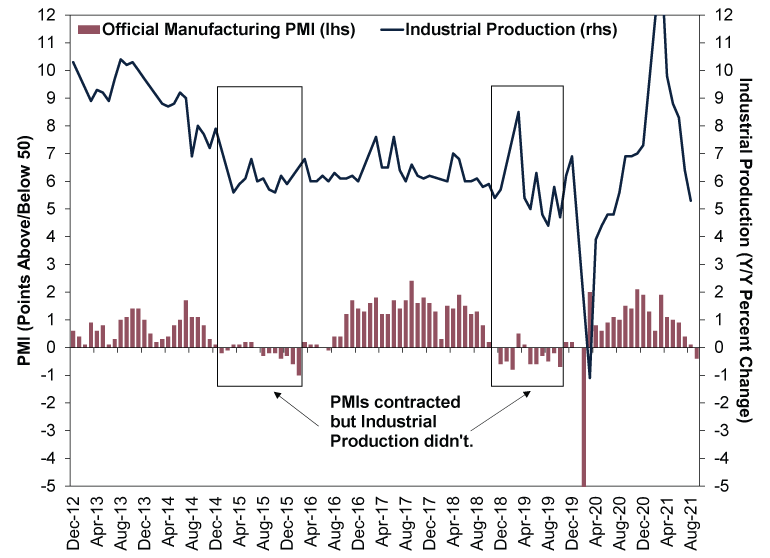Personal Wealth Management / Market Analysis
China’s PMI Dip: Another Brick in the Wall of Worry
Manufacturing purchasing managers’ index (PMI) contractions aren’t unusual in China.
Thursday brought the first look at how China’s electricity shortage is affecting the economy, and the results weren’t exactly pretty: The government’s official manufacturing purchasing managers’ index (PMI) sank to 49.6 in September, implying contraction.[i] Caixin’s PMI, which includes a host of smaller private firms, technically broke even at 50.0, but its production subcomponent remained in contractionary territory, according to commentary from Caixin and IHS Markit.[ii] In response to these survey results, many analysts we follow warned that China’s energy crisis is adding to economic pressures, jeopardising the global recovery from the pandemic and lockdowns. In our view, that is just a tad hasty, and the likelihood that global markets will have to reckon with a hard landing in the world’s second-biggest economy remains low.
When interpreting PMIs, we think it is helpful to consider both their quirks and their history. They do not measure—or even attempt to measure—how much activity increases from month to month. That responsibility lies with output measures like industrial production. PMIs, by contrast, are surveys. Businesses report on whether output, new orders, employment, supplier delivery times, sentiment and other categories rose or fell versus the prior month. Then the agency producing the PMI compiles all the results and computes them into an index. The index’s reading, roughly, is the percentage of businesses reporting increased economic activity overall. If it exceeds 50, a majority of firms reported expansion, which implies the sector grew. If it is below 50, it implies contraction. So September’s 49.6 manufacturing PMI means a slight minority of firms reported expansion.
But because the PMI doesn’t measure how much businesses grew, the relationship between PMIs and output is fuzzy at best. If only 49.6% of businesses reported growth, but they grew by more than the others contracted, then output can still rise in a given month. So whilst we think PMIs are handy, as they are generally amongst the first economic indicators released for a given month, we think it is best to take them with a grain of salt. We suggest not getting too excited by incremental moves down or up, especially when they are very close to 50, like China’s latest figures.
China’s own history vets this out, in our view. The official manufacturing PMI has had two lengthy contractionary spells in recent history—one in 2014 – 2015 and one in 2019. As Exhibit 1 shows, industrial production continued growing both times. It slowed somewhat at points, but the growth rates remained healthy overall, and China continued contributing mightily to global GDP growth.[iii] The only time a contracting PMI signalled an actual economic contraction was in February 2020, when China’s COVID lockdowns were at their strictest.
Exhibit 1: Chinese Manufacturing PMI and Industrial Production

Source: FactSet and National Bureau of Statistics, as of 30/9/2021. Y-axes truncated at -5 and 12 to improve visibility and clarity.
Granted, China wasn’t dealing with rolling blackouts during either of those spells, but it wasn’t without headwinds. In 2014 and 2015, manufacturing globally hit the skids, but China got an extra thumping from the government’s efforts to curb supply excesses in steel and other industries.[iv] In 2019, our research indicates it was a continued crackdown on the shadow banking realm and local government debt issuance, which triggered a broad economic slowdown.[v]
In our view, the electricity shortages are just the latest in a long line of external headwinds Chinese businesses have had to deal with—and our research indicates they have become very good at doing so over time. Necessity is the mother of invention, and factory owners don’t want to close shop just because their power supplier has gone dark. Plus, China has a long history of intermittent power outages due to the retail price limits imposed on suppliers—this bout is just getting more international attention than usual. As several outlets have reported this week, businesses throughout the country have turned to diesel generators as an alternative.[vi] That may not be a great solution, but it likely cushions output a lot more than much of the PMI coverage we encountered seemingly suggests.
In our view, the great global power freakout has all the hallmarks of a classic ghost story for shares—the sort of tale that we find often accompanies volatility and corrections (sharp, sentiment-driven drops of -10% to -20%). Global equity markets, which fell -1.2% today, aren’t yet in correction territory, but they could get there.[vii] We think it is pretty easy to envisage how China’s power woes could collide with Britain’s petrol lines and Europe’s natural gas shortage to continue spooking markets globally for a while longer. The electricity issue is one society hasn’t had to deal with for some time, and it raises what seems to be one of financial commentators’ favorite bogeymen: comparisons with the 1970s.
But in our view, the silver lining when ghost stories and volatility collide is that, whether or not said ghost story actually caused said volatility, we have found people naturally conflate correlation and causation: They see the thing they fear having the effect they feared, and they think, I was right. Then, when markets recover, this quirk of human nature prompts them to think the problem has run its logical course and isn’t a threat anymore. That knocks one item off their worry list, lifting investor sentiment a bit. We think that gradual warming is what long equity market rallies are made of—a textbook case of shares climbing the proverbial wall of worry.
[i] Source: FactSet, as of 30/9/2021.
[ii] Source: IHS Markit, as of 30/9/2021.
[iii] Source: World Bank, as of 30/9/2021. Statement based on national gross domestic product in US dollars. Gross domestic product is a government-produced measure of economic output.
[iv] “China Steelmakers Bring Forward Maintenance, Try to Dent Oversupply,” Staff, Reuters, 22/1/2015.
[v] Source: FactSet, as of 30/9/2021.
[vi] “Chinese Switch to Flashlights, Generators Amid Power Cuts,” Staff, Associated Press, 29/9/2021.
[vii] Source: FactSet, as of 30/9/2021. MSCI World Index price return in GBP on 30/9/2021.
Get a weekly roundup of our market insights.
Sign up for our weekly e-mail newsletter.

See Our Investment Guides
The world of investing can seem like a giant maze. Fisher Investments UK has developed several informational and educational guides tackling a variety of investing topics.




